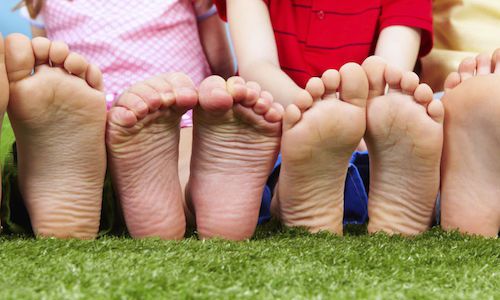Kids Feet
Essential Foot Care for Kids: Ensuring Healthy Development and Preventing Problems
Our Locations: Sydney CBD, Mosman, Rose Bay, Dee Why, Ryde

Kid’s feet are not simply smaller versions of adult feet. In fact, they are still developing, with bones, muscles, and ligaments growing rapidly. Kids’ feet contain a higher proportion of cartilage, which gradually ossifies into bone as they age. This makes young feet particularly susceptible to injury and deformities if not properly cared for.
Additionally, children are often unaware of foot pain or discomfort, and they may not recognise problems themselves. This is why regular checks by a podiatrist are important. ModPod Podiatry provides professional assessments and advice for managing and improving the health of kids’ feet throughout every stage of development.
Key Stages of Foot Development
Infancy to Toddler Stage (0–3 years)
During the first few years of life, babies and toddlers undergo rapid physical changes. Foot arches are not yet fully developed, so it’s common for young children to have flat feet. As they begin to walk, parents may notice their child walks with their feet turned in or out. This is usually normal and resolves as the muscles and tendons strengthen.
At this stage, it’s vital to allow children’s feet to develop naturally. Babies should spend time barefoot to encourage healthy muscle and bone development. When shoes are needed, soft, flexible shoes that mimic the foot’s natural movement are best for this age group.
Preschool and Early School Age (3–7 years)
As kids start school, their activity levels increase, which can put more strain on their feet. By this age, most children’s foot arches begin to form, but some may still have flat feet. In-toeing (pigeon-toed walking) and out-toeing (duck-footed walking) can persist during these years. If these patterns don’t resolve naturally, it may indicate an underlying issue that requires intervention.
Footwear plays a crucial role during this stage. Shoes should provide adequate support, especially in the arch and heel, to encourage proper alignment and development.
Older Children and Pre-Teens (7–12 years)
By this age, kids’ feet resemble those of adults in structure, but their bones are still growing and hardening. It’s important to address any foot or leg pain that develops during these years. Active children participating in sports may experience foot and ankle injuries or conditions like Sever’s disease (heel pain due to growth plate inflammation). Addressing these issues early on can prevent long-term problems.
Common Foot Conditions in Kids
Many foot conditions in kids are developmental and can be corrected with proper treatment and monitoring. Here are some common issues parents should be aware of:
Flat Feet: While flat feet are normal in toddlers, persistent flat feet beyond the age of five may need attention. If flat feet cause pain or affect a child’s ability to run or walk, a podiatrist might recommend custom orthotics to support the arch.
In-toeing and Out-toeing: These conditions often correct themselves as children grow. However, if the walking pattern persists beyond early childhood or leads to frequent trips and falls, it’s essential to consult a podiatrist for further evaluation.
Heel Pain (Sever’s Disease): Heel pain is common in active children, especially during growth spurts. Sever’s disease occurs when the growth plate in the heel becomes inflamed due to repetitive stress. Rest, stretching exercises, and appropriate footwear can help manage the condition.
Warts and Ingrown Toenails: Children often get warts on their feet due to viral infections, and tight-fitting shoes can cause ingrown toenails. Both conditions are treatable but may require professional care to avoid complications.
Foot Injuries: Sports and physical activities can lead to sprains, fractures, or overuse injuries. Proper diagnosis and treatment ensure quick recovery and reduce the risk of long-term damage.
Footwear Tips for Kids
Choosing the right shoes for kids is one of the most effective ways to support healthy foot development. Here are a few tips to keep in mind:
Proper Fit: Shoes that are too tight or too loose can cause discomfort and foot problems. Ensure that shoes fit well with enough room for toes to wiggle, and check regularly for changes as kids’ feet grow quickly.
Supportive Soles: Shoes with good arch support and cushioned soles help absorb impact, particularly for active children.
Breathable Materials: Kids tend to sweat more, so choose shoes made from breathable materials like leather or mesh to prevent fungal infections and foot odour.
Avoid Hand-Me-Downs: Footwear conforms to the shape of the original wearer’s foot. Hand-me-down shoes may not offer the support needed for a different child’s foot structure.
How ModPod Podiatry Can Help
At ModPod Podiatry, we specialise in caring for kids’ feet by providing comprehensive assessments and treatments tailored to your child’s needs. Our experienced podiatrists use cutting-edge diagnostic tools to monitor foot development and identify any potential problems early on.
We offer a range of services, including:
- Custom orthotics: Designed to correct imbalances and provide support for conditions like flat feet.
- Gait analysis: Used to assess your child’s walking patterns and identify any abnormal foot function.
- Injury management: Whether it’s a sprained ankle or overuse injury, we provide expert care to ensure a quick recovery.
Conclusion
Foot health is essential for a child’s overall well-being and development. Monitoring and supporting your child’s foot growth can prevent future problems and ensure they stay active and healthy. By paying attention to footwear, recognising symptoms of foot conditions early, and seeking professional care when necessary, you can help your child maintain strong, healthy feet.
At ModPod Podiatry, we’re committed to providing top-quality foot care for kids. If you’re concerned about your child’s foot development or if they’re experiencing foot pain, contact us today to schedule a consultation. We’ll work with you to keep your child’s feet healthy and strong for life.







